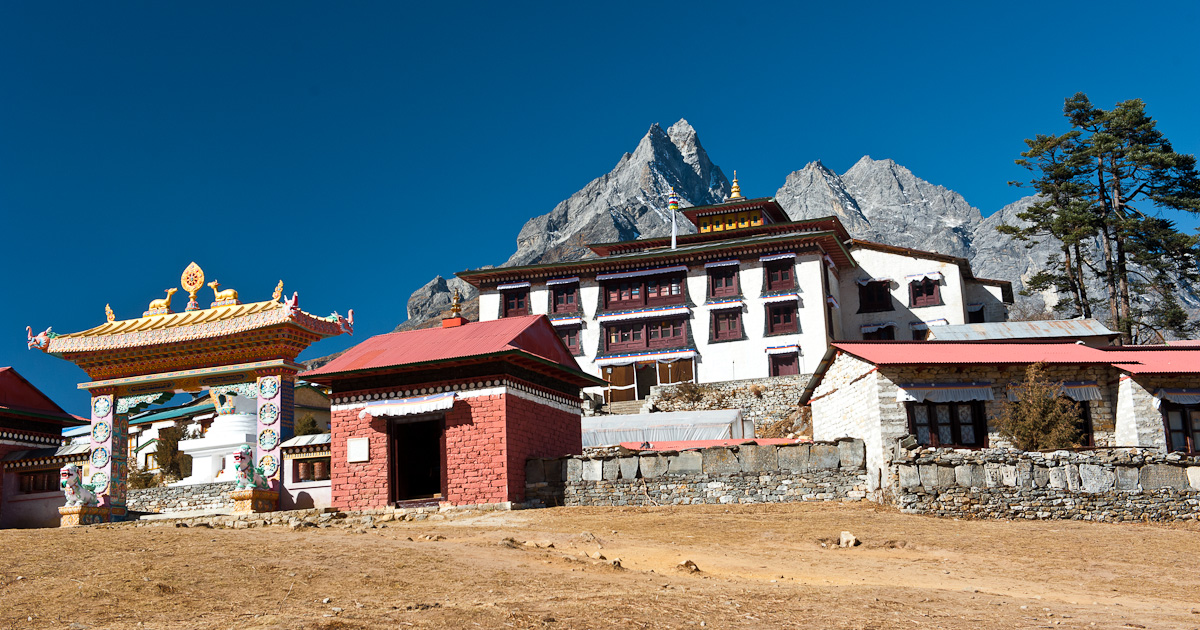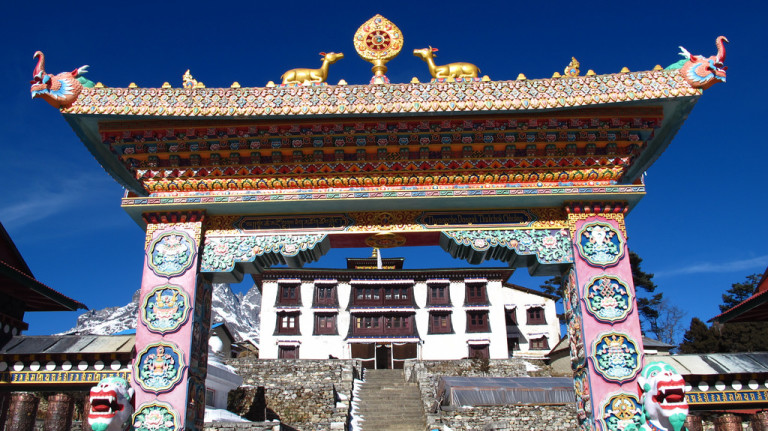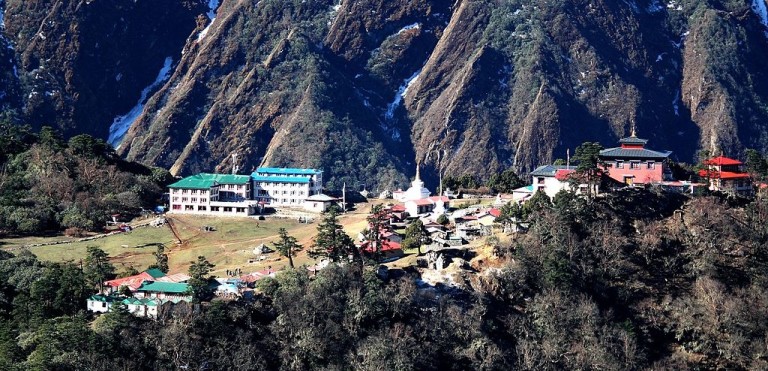- HOME
- Destination
- Adventure Activities
- About Us
- BLOGS
- CONTACT US

Buddhism is the second most followed religion of Nepal after Hinduism. There are several gompas (monastery) which stand as sacred pilgrimage sites for Buddhists. Among several of those pilgrimage sites, Tengboche Monastery is also one.
Tengboche Monastery, also known as Thyangboche Monastery or Dawa Choling Gompa is Tibetan Buddhist monastery of Sherpa community. It is located in the Tengboche village of Khumbu region at an elevation of 3,867 metres/12,687 ft. Tengboche Monastery is the largest gompa of Khumbu region.
Tengboche Monastery lies in the Sagarmatha National Park which offers a beautiful panoramic view of magnificent mountains Mount Everest, Lhotse, Tawache, Ama Dablam, and Thamserku. Tengboche is also the “Sacred Site Trail Project” of the Sagarmatha National Park. The trail is circular which covers ten monasteries in a clockwise direction ending in the Tengboche Monastery.
Apart from the view of mountain views, Tengboche Monastery is probably one of the most beautiful places in the world with the height of over 12,000 feet. The building of monastery stands up a knoll at the end of a big spur, which is flung out across the direct axis of the river Imja.
Satellite dwellings surround it, all of them quaintly constructed. Also, Tengboche Monastery falls en route to Everest Base Camp.

Tengboche Monastery
According to ancient Tibet scripture, Khumbu valley, along with Rowlang and Khanbalung valley is referred as a sacred place. Khumbu valley got under the influence of Buddhism for about 350 years ago. Lama Sangwa Dorje is known as the founder of oldest monastery along with other small hermitages in Khumbu region, and he prophesized the suitability of establishing a monastery at Tengboche.
Although the establishment of Tengboche Monastery was prophesized a long ago, it was established in 1916 in its present location. Ngwang Tenzin Norbu, who was considered as the fifth incarnation of Sangwa Gorje blessed Chatang Chitar (Lama Gulu) to establish the Tengboche monastery at Tengboche village.
As a result, the monastery was founded. Tengboche monastery is the first celibate monastery of Vajrayana Buddhism under the Nyingmapa lineage.
For the funding of the monastery building, the three wealthy inhabitants of the local Sherpa community are credited. Karma, one of the three, was one of the most influential. Apart from the Sherpas of Khumbu, Sherung Sherpa have been involved with the building of the monastery.
During the initial year of establishment of Tengboche Monastery, nuns came, studied and practices Buddhism in the monastery as Vajrayana Buddhism does not restrict the gender. Over the years, nuns wanted their place to live and prayed and the head of the monastery, Lama Gulu, granted them land in a small valley called Devoche where a nunnery was established as Devoche/Debuche Nunnery (Ani). Tengboche itself administers the nunnery.
It is said that the monastery has 60 monks. However, fewer boys are joining as monks because they see more prospect in mountaineering and trekking related activities and prefer to work in that field.

Tengboche Monastery at Night
This historical site has gone through pretty much of disaster in the past, and the earthquake in 2015 is the recent one. Although the 2015 earthquake was catastrophic, Tengboche Monastery suffered just small damages which were immediately recovered later.
However in past year, 1934 earthquake, the monastery was destroyed. Later, the founder of the monastery, Lama Gulu passed away and Umze Gelden, his successor, took the responsibility of rebuilding. With the help and support of monks and the local community, the monastery was rebuilt with exclusive mural painting.
But, the monastery went through another disaster in 1989, a devastating fire caused by the electrical short circuit. The fire destroyed the precious old scriptures, murals, statues and wood craving of monastery along with the monumental stone credited with Lama Sangwa Dorje’s left footprint.
Trekkers saved only a few books and paintings. Tengboche Monastery has since been rebuilt completely from the donation around the world.
Tengboche Monastery is probably one of the most beautiful places in the world with the height of over 12,000 feet. The building of monastery stands up a knoll at the end of a big spur, which is flung out across the direct axis of the river Imja. Satellite dwellings surround it, all of them quaintly constructed.
Tengboche Monastery is one of the sacred sites of Buddhist and a very popular one. No doubt, the monastery celebrates several festivals, and among those festivals, Mani Rimdu is the most important one in the Sherpa Community. Mani means “part of the chant of Chenrezig and Rimdu means “small red pills that are blessed during the festival.”
The festival falls in the tenth lunar month of Tibetan calendar, which falls on the autumn season. The tradition of this festival is passed to Tengboche from the Rongbuk Monastery. This festival lasts for 19 days and involves several ceremonies and meditation.
The festival begins with a large depiction of the mandala diagram made of colored sand, which is extracted from the specified location in the hills. It takes four days to draw the mandala and then it is covered and is the serves as the center of the festival for the remaining days.
The festival includes 16 dance number. At the end of the festival when all the devotees are left, the monks perform a fire rite to eliminate the negative energy and harm of the world. Then, the mandala is formally removed with the prayers for the benefit of all the sentient beings.

Tengboche Monastery from distance
As I said, Tengboche Monastery is in the route of Everest Base Camp trek, but you can skip the whole trek and go for Tengboche Monastery. Either way, the route is same up to the Monastery and from the monastery you go further to base camp and descent the same way after reaching the destination.
Your journey starts from the Kathmandu itself, from where you can take a flight to Lukla. From Lukla, you will reach Phadking after 4-5 hours of trekking. Phadking is a small village in the north of Lukla. From Phadking, you will reach Namche Bazar, a small town, trading center and hub of Khumbu region.
Then your journey takes you on descending trail to Phungi Tenga, where you will pass through suspension bridges and follow the uphill trail through delightful rhododendron, pine, and birch forest all the way up to Tengboche Monastery.
After reaching Tengboche monastery, Dingboche will be your next stop, from where you will reach Labuje. Your ultimate destination will arrive after Gorakshep, the base camp of Mount Everest. After reaching the camp and returning to Gorakshep, you can go for Kala Patthar, which offer a close view to Mount Everest. Then, from Kala Patthar, you will return to Namche Bazaar and then to Lukla. Then finally at Kathmandu from where you will head to next destination.
The best time to pay a visit to Tengboche Monastery, as well as the trek to Everest Base Camp, is April, May, September, October, and November. During these months, it wouldn’t be as cold as in winter and the weather remains clear most of the time allowing you to enjoy the mesmerizing views of the Himalayas.
Also, it is not recommended to go during the monsoon time, as the trails will be very slippery full of leeches, high probability of flight cancellation, and the risk of getting caught up in landslides due to all the rains and storms.
Your email address will not be published.Required fields are marked *
You must be logged in to post a comment.
0 Comments on "Tengboche Monastery: The Largest Monastery of Khumbu region"